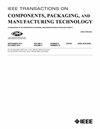高密度玻璃中间体中小直径、高纵横比玻璃通孔的双面铜填充
IF 3
3区 工程技术
Q2 ENGINEERING, ELECTRICAL & ELECTRONIC
IEEE Transactions on Components, Packaging and Manufacturing Technology
Pub Date : 2025-04-02
DOI:10.1109/TCPMT.2025.3557232
引用次数: 0
摘要
与目前的有机基板相比,玻璃基板具有显著的优势,特别是在高密度、高性能芯片封装方面,适用于人工智能(AI)等数据密集型应用。具有超低平面度的玻璃增强了光刻中的聚焦深度,这有助于在先进的金属互连处精确地进行图案设计。此外,其优越的热稳定性最大限度地减少了图案失真,其出色的机械稳定性支持超大封装尺寸。这些卓越的尺寸稳定性有助于精确的层对层互连对齐,最终使玻璃基板实现比有机基板高十倍的互连密度。然而,制造高密度、小直径、高纵横比(AR)玻璃通孔(tgv)仍然是一个重大挑战。目前最先进的垂直tgv技术实现了12的AR,通孔直径为30~ $ μ m。在这项工作中,我们首次展示了直径为20 ~ $\ μ m的直tgv,在300 ~ $\ μ m厚的硼硅玻璃上,实现了创纪录的15的AR。由于大面积封装成本低,热膨胀系数低,热稳定性好,高频工作时电耗散小,本研究选择硼硅酸盐作为玻璃基板。对于直的、高AR的tgv,本研究探索了一种双面种子层增强(SLE)方法,使用化学沉积来增强种子层,结合电镀策略来生产无空隙的、完全填充的直tgv金属互连。SLE过程的参数研究为未来高互连密度3d集成系统制造高AR tgv提供了有价值的见解和指导。本文章由计算机程序翻译,如有差异,请以英文原文为准。
Double-Sided Copper Filling of Small Diameter, High-Aspect Ratio Through-Glass Vias in High-Density Glass Interposers
Glass substrates offer significant advantages over current organic substrate, particularly in high-density, high-performance chip packaging for data-intensive applications such as artificial intelligence (AI). Glass with ultralow flatness enhances the depth of focus in lithography, which helps pattern precisely at advanced metal interconnects. In addition, their superior thermal stability minimizes pattern distortion, and their outstanding mechanical stability supports ultralarge package sizes. These exceptional dimensional stability properties facilitate precise layer-to-layer interconnect alignment, ultimately enabling glass substrates to achieve ten times higher interconnect density compared to organic substrates. However, fabricating high-density, small-diameter, high-aspect ratio (AR) through-glass vias (TGVs) remains a significant challenge. The current state-of-the-art technology for vertical TGVs achieves an AR of 12, with a via diameter of $30~\mu $ m. In this work, we present the first demonstration of straight TGVs with 20- $\mu $ m diameters on 300- $\mu $ m thick borosilicate glass, achieving a record-high AR of 15. Thanks to the low large-area packaging cost, low thermal expansion coefficient, excellent thermal stability, and low electrical dissipation in high-frequency operation, borosilicate is chosen as the glass substrate in our research. For straight, high AR TGVs, this study explores a double-sided seed layer enhancement (SLE) approach using electroless deposition to reinforce the seed layer, combined with an electroplating strategy to produce void-free, fully filled straight TGVs metal interconnects. The parameter study of the SLE process provides valuable insights and guidelines for fabricating high AR TGVs for future high interconnect density 3-D integration systems.
求助全文
通过发布文献求助,成功后即可免费获取论文全文。
去求助
来源期刊

IEEE Transactions on Components, Packaging and Manufacturing Technology
ENGINEERING, MANUFACTURING-ENGINEERING, ELECTRICAL & ELECTRONIC
CiteScore
4.70
自引率
13.60%
发文量
203
审稿时长
3 months
期刊介绍:
IEEE Transactions on Components, Packaging, and Manufacturing Technology publishes research and application articles on modeling, design, building blocks, technical infrastructure, and analysis underpinning electronic, photonic and MEMS packaging, in addition to new developments in passive components, electrical contacts and connectors, thermal management, and device reliability; as well as the manufacture of electronics parts and assemblies, with broad coverage of design, factory modeling, assembly methods, quality, product robustness, and design-for-environment.
 求助内容:
求助内容: 应助结果提醒方式:
应助结果提醒方式:


